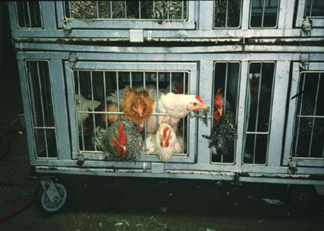Overseeing monitoring in New York's live bird markets
By Susan Lang

With 25 million chickens, turkeys, guinea fowl, geese and other edible birds coming through live poultry markets in the Northeast every year, field technicians are constantly taking random samples to monitor for avian influenza viruses. It is a vital part of a program to detect health threats to animals and, potentially, the public.
Overseeing the five field technicians who take some 1,000 samples each week from New York state's 90 bird markets, which are mostly in the New York City area, is Susan C. Trock, a veterinary extension epidemiologist at Cornell University's Veterinary Diagnostic Laboratory, assigned to the New York State Department of Agriculture and Markets in Albany. A product of the Centers for Disease Control and Prevention's Epidemic Intelligence Service, she is well prepared to conduct field investigations for zoonotic (disease that humans can get from animals) and animal infectious disease agents.
To monitor for avian influenza, the technicians take swabs from a bird's trachea and cloaca (the cavity into which the intestinal and genitourinary tracts empty) as well as samples from the market environment, such as the walls and floors, "to be sure that everything is kept clean," says Trock. "Although avian influenza viruses, which are shed through a bird's feces, won't replicate in the environment, they can stay alive for several months, just waiting to be picked up by some live bird," she adds.

Markets that are found to have any avian flu viruses, even the fairly common low-pathogenic ones, must eliminate the bird population by slaughtering and destroying or selling off birds, pressure wash and then disinfect the entire facility. Even markets that test negative for avian flu viruses must follow the same procedure at least quarterly.
Low-pathogenic avian influenza viruses have been circulating in the Northeastern live bird markets since 1986, particularly in the New York and New Jersey metropolitan areas. Since 1994, a low-pathogenic avian influenza subtype virus (H7N2) has been detected in these retail markets and has shown up from time to time in their suppliers.
In the early 1980s, a different avian influenza strain crippled the Pennsylvania poultry industry, forcing the slaughter of some 17 million birds; the result was an estimated loss to producers of $400 million and expense to American taxpayers of $50 million when the federal government partially compensated poultry producers.
The surveillance of the New York live poultry markets includes analyzing the genome of the viruses, says Trock. If any new strains of the virus do threaten the multibillion dollar U.S. poultry industry or public health, then an early warning will come from trends noted through this analysis.
This monitoring goes on, day in and day out as just one component of the ongoing multi-state surveillance for avian influenza viruses.
Media Contact
Get Cornell news delivered right to your inbox.
Subscribe